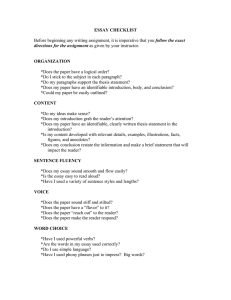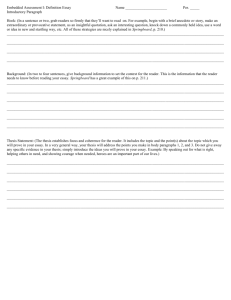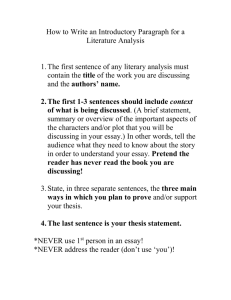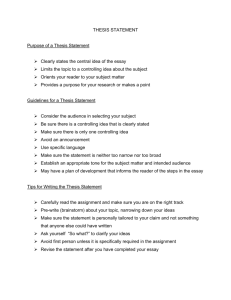Module 12 Composing an Introduction Matakuliah : G1222, Writing IV
advertisement
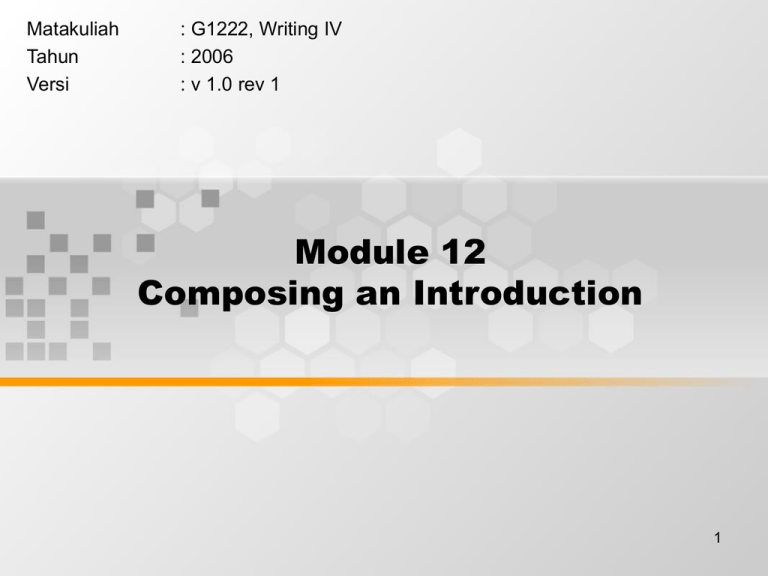
Matakuliah Tahun Versi : G1222, Writing IV : 2006 : v 1.0 rev 1 Module 12 Composing an Introduction 1 What’s inside • The function of an introduction • The Structure Of An Introduction 2 What is an introduction? "You tell 'em what you're gonna tell 'em you tell 'em, and then you tell 'em what you told 'em." 3 What is Introduction? The introduction of a paper can be understood as a type of transition. … At the beginning of a paper, the introduction serves as a transition by moving the reader from the world outside of your paper to the world within. At the end of the paper, the conclusion works in the opposite direction by moving readers from the world of your paper back to their own world . . .(151) 4 Purposes Introductions have two primary purposes: • • They establish a frame of reference for the reader The introduction should inform the reader of your paper's general topic, the interdisciplinary perspective you have adopted (whether you are writing as a student, a reporter, etc.) and the type of terminology, evidence and logic he or she can expect throughout the paper. They invite the reader to continue reading the rest of the paper. The introduction should provide necessary background information and grab his or her attention in order to direct it towards the thesis and the entire paper. 5 How am I supposed to do that? 1. Reveal your topic to your reader, and be sure that he or she will be able to anticipate your use of language, evidence and logic. 2. Use the introduction to provide necessary background information, which might include defining terms, giving a historical overview or informing the reader of a controversy. 3. If it is not necessary to provide background information on your subject, focus more on the introduction as a means of stimulating your reader's interest in the paper. 4. Once you have provided the necessary hints and background information and have gained the interest of your reader, manipulate his or her interest towards your thesis, generally the last sentence of the introductory paragraph. 6 The Structure Of An Introduction In an introduction, you lay out a plan for what will follow. However, there is more to writing an introduction than merely summarizing the points of your essay; you must find a way to open discussion of the topic. There are several ways to do this, but a simple and effective method uses the analogy of a triangle. 7 The Structure Of An Introduction In this model, your introduction begins with the general and moves toward the specific, as the sides of the triangle narrow toward a point. Ask yourself how the specific question you are addressing in the essay relates to a greater issue or field. The question you take up in your essay does not exist in a vacuum; it arises out of a greater set of concerns. Your introduction can provide this background so that the reader is not coming to the discussion cold: ask yourself what your audience knows already, and what it needs to know in order to understand the context for your thesis. • By the time you reach the end of your introductory paragraph, you should be ready to state the thesis of your essay. The introduction need not give away all your opinions and conclusions, but you should give your reader a clear idea of what you will be discussing. 8 The Length Of An Introduction The introduction should be brief relative to the rest of the essay. If the opening is inappropriately lengthy, the reader will lose interest, annoyed that you have failed to get started. Do not include unnecessary background information, especially if the audience is already conversant with the material on which you are writing. Try not to be too self-referential in your introduction, or elsewhere for that matter. When you talk to someone you do not continually remind that person that you are having a conversation. Avoid sentences like "It is this problem that my essay will focus upon." 9 The length Of An Introduction 1. An introduction should generally be four to five sentences long. Begin your introduction with a general statement, and with each sentence that follows get more and more specific until you get to the last sentence, which is a clearly stated thesis. This thesis states the point of your paper. The thesis should be like an umbrella which spans your essay, including all major points found in the essay. 2. After you have brainstormed your topic, answer the following questions: "Who," "What," "When," "Where," "Why," and "How." Although it is not always necessary or possible to answer all of these, you should be able to answer some of them, and the questions not only give you a starting point, but provide your reader the needed background to put your essay into context. 10 STEPS STEPS IN WRITING AN INTRODUCTION 1. Write a definition of the field you are interested in. 2. Write 2-3 general facts about the field. 3. Write 1-3 questions about the field that you are interested in and think important to the readers. 4. Write a statement of purpose for your paper. 11 Examples Who Robert Frost What The poems "Birches" and "Acquainted with the Night" When Does not apply Where Does not apply Why The same poet can portray both the darker and lighter sides of life How Through tone of the poetry using setting, imagery, and structure 12 Examples General sentence Dealing with emotional issues can be both complicated and perplexing. Less general sentence Now and then, a poet is willing to expose two very distinct facets of his or her emotional nature. Even less general (more specific) Such a poet is courageous enough to look back on sadder times, as well as to recollect a fond memory--a writer honest enough to know that life includes both the swing of birches and the darker moments of the soul. Even more specific Robert Frost is such a poet. Specific thesis The difference in the tone of his poems "Birches" and "Acquainted With the Night" reveals a poet equally adept at portraying both the lighter and darker sides in life through his use of setting, imagery and structure. 13 Example 1 The ad for Maybelline’s moisture whip gloss stick for lips is kept brief enough not to strain anyone’s attention, but does provide enough visual stimulation and verbal precision for the viewer to understand the message Maybelline wants to get across to you. The ad has a picture of a big tube of the moisture whip gloss stick in the bottom right hand corner and a picture of the model Christy’s face located at the bottom left hand corner with a close up of her lips wearing the moisture whip gloss in the shade of Bearly Wine. At the top of the ad, in the left hand corner, there is a picture of Christy, the model, and a guy with just a waist and up view. Christy has her hands on his shirt, and her lips are puckered up ready to be kissed. 14 Example 2 "I’d walk a mile for a camel." "Come to Malboro Country." "You’ve Come a Long Way, Baby." Practically every consumer, including those who do not smoke and would never even consider taking up the habit, can easily identify each of the above slogans as an advertisement for cigarettes. Advertising is all around us, bombarding us on every level. It is so widespread and pervasive that we rarely give it a second thought. However, the images presented in these advertisements are etched in our minds whether we choose to admit it or not. Even children in our culture are not immune to the effects of advertising. In fact, children and adolescents are now targeted in Cigarette campaigns as potential purchasers of tobacco products. Our children are potential victims of unscrupulous individuals who would use a cartoon character such as Joe Camel to sell cigarettes to adolescents. Cigarette advertisers use all their wiles to deliberately seduce the buying public, including children, to purchase deadly products. Since their only real concern is their bottom line they clearly do not act in the best interest of the consumer. 15

